NODAL secreted by male germ cells regulates the proliferation and function of human Sertoli cells from obstructive azoospermia and nonobstructive azoospermia patients
- PMID: 26289399
- PMCID: PMC4814958
- DOI: 10.4103/1008-682X.159722
NODAL secreted by male germ cells regulates the proliferation and function of human Sertoli cells from obstructive azoospermia and nonobstructive azoospermia patients
Abstract
This study was designed to explore the regulatory effects of male germ cell secreting factor NODAL on Sertoli cell fate decisions from obstructive azoospermia (OA) and nonobstructive azoospermia (NOA) patients. Human Sertoli cells and male germ cells were isolated using two-step enzymatic digestion and SATPUT from testes of azoospermia patients. Expression of NODAL and its multiple receptors in human Sertoli cells and male germ cells were characterized by reverse transcription-polymerase chain reaction (RT-PCR) and immunochemistry. Human recombinant NODAL and its receptor inhibitor SB431542 were employed to probe their effect on the proliferation of Sertoli cells using the CCK-8 assay. Quantitative PCR and Western blots were utilized to assess the expression of Sertoli cell functional genes and proteins. NODAL was found to be expressed in male germ cells but not in Sertoli cells, whereas its receptors ALK4, ALK7, and ACTR-IIB were detected in Sertoli cells and germ cells, suggesting that NODAL plays a regulatory role in Sertoli cells and germ cells via a paracrine and autocrine pathway, respectively. Human recombinant NODAL could promote the proliferation of human Sertoli cells. The expression of cell cycle regulators, including CYCLIN A, CYCLIN D1 and CYCLIN E, was not remarkably affected by NODAL signaling. NODAL enhanced the expression of essential growth factors, including GDNF, SCF, and BMP4, whereas SB431542 decreased their levels. There was not homogeneity of genes changes by NODAL treatment in Sertoli cells from OA and Sertoli cell-only syndrome (SCO) patients. Collectively, this study demonstrates that NODAL produced by human male germ cells regulates proliferation and numerous gene expression of Sertoli cells.
Figures
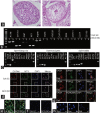


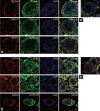


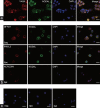
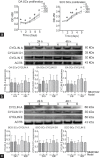
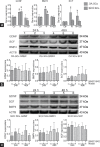

Similar articles
-
Sertoli cells from non-obstructive azoospermia and obstructive azoospermia patients show distinct morphology, Raman spectrum and biochemical phenotype.Hum Reprod. 2013 Jul;28(7):1863-73. doi: 10.1093/humrep/det068. Epub 2013 Mar 15. Hum Reprod. 2013. PMID: 23503944
-
BMP4 promotes human Sertoli cell proliferation via Smad1/5 and ID2/3 pathway and its abnormality is associated with azoospermia.Discov Med. 2015 Apr;19(105):311-25. Discov Med. 2015. PMID: 25977194
-
A differential cytokine expression profile before and after rFSH treatment in Sertoli cell cultures of men with nonobstructive azoospermia.Andrologia. 2017 May;49(4). doi: 10.1111/and.12647. Epub 2016 Jul 21. Andrologia. 2017. PMID: 27444581
-
Mechanisms of hormonal regulation of sertoli cell development and proliferation: a key process for spermatogenesis.Curr Mol Pharmacol. 2014;7(2):96-108. doi: 10.2174/1874467208666150126155032. Curr Mol Pharmacol. 2014. PMID: 25620228 Review.
-
Progress in understanding the molecular functions of DDX3Y (DBY) in male germ cell development and maintenance.Biosci Trends. 2017 Mar 22;11(1):46-53. doi: 10.5582/bst.2016.01216. Epub 2017 Feb 12. Biosci Trends. 2017. PMID: 28190795 Review.
Cited by
-
Fibroblast growth factor-5 promotes spermatogonial stem cell proliferation via ERK and AKT activation.Stem Cell Res Ther. 2019 Jan 22;10(1):40. doi: 10.1186/s13287-019-1139-7. Stem Cell Res Ther. 2019. PMID: 30670081 Free PMC article.
-
Omega-3 polyunsaturated fatty acids and its metabolite 12-HEPE rescue busulfan disrupted spermatogenesis via target to GPR120.Cell Prolif. 2024 Feb;57(2):e13551. doi: 10.1111/cpr.13551. Epub 2023 Sep 24. Cell Prolif. 2024. PMID: 37743695 Free PMC article.
-
Testis cell pyroptosis mediated by CASP1 and CASP4: possible sertoli cell-only syndrome pathogenesis.Reprod Biol Endocrinol. 2023 Jun 9;21(1):53. doi: 10.1186/s12958-023-01101-w. Reprod Biol Endocrinol. 2023. PMID: 37296437 Free PMC article.
-
Transcriptomic analysis of dead end knockout testis reveals germ cell and gonadal somatic factors in Atlantic salmon.BMC Genomics. 2020 Jan 30;21(1):99. doi: 10.1186/s12864-020-6513-4. BMC Genomics. 2020. PMID: 32000659 Free PMC article.
-
miR-202-3p Regulates Sertoli Cell Proliferation, Synthesis Function, and Apoptosis by Targeting LRP6 and Cyclin D1 of Wnt/β-Catenin Signaling.Mol Ther Nucleic Acids. 2019 Mar 1;14:1-19. doi: 10.1016/j.omtn.2018.10.012. Epub 2018 Oct 25. Mol Ther Nucleic Acids. 2019. PMID: 30513418 Free PMC article.
References
-
- Ma M, Yang S, Zhang Z, Li P, Gong Y, et al. Sertoli cells from non-obstructive azoospermia and obstructive azoospermia patients show distinct morphology, Raman spectrum and biochemical phenotype. Hum Reprod. 2013;28:1863–73. - PubMed
Publication types
MeSH terms
Substances
Supplementary concepts
LinkOut - more resources
Full Text Sources
Research Materials

